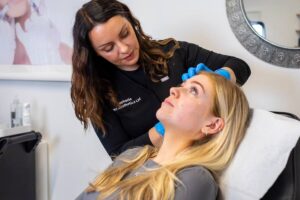Hair loss can be a distressing experience, impacting self-esteem and confidence. As advancements in aesthetic medicine continue to evolve, Platelet-Rich Plasma (PRP) therapy has emerged as a promising non-surgical solution for combating hair loss. At Ness Aesthetics, we are committed to offering cutting-edge treatments to help you achieve fuller, healthier hair. Here’s an in-depth look at PRP hair loss treatment, including its benefits, the treatment process, and what you can expect in terms of results.
What is PRP Hair Loss Treatment?
PRP hair loss treatment is a non-invasive procedure that uses your own blood to stimulate hair growth. The process involves extracting Platelet-Rich Plasma (PRP) from your blood and injecting it into the scalp to promote natural hair regeneration.
Key Components:
- Platelets: These are blood cells that help in healing and tissue regeneration. PRP is rich in platelets and growth factors that promote hair follicle health and stimulate hair growth.
- Plasma: The liquid part of the blood that contains essential nutrients and growth factors necessary for repairing and rejuvenating tissues.
The PRP Treatment Process
Understanding the PRP treatment process can help you feel more comfortable and prepared for the procedure. Here’s a step-by-step guide to what you can expect:
- Initial Consultation
- Assessment: Your first step will be a consultation with a qualified specialist at Nessa Aesthetics. During this visit, your hair loss concerns will be assessed, and your suitability for PRP treatment will be determined.
- Discussion: You’ll discuss your goals, the treatment plan, and any potential risks or benefits.
- Blood Collection
- Preparation: A small amount of blood will be drawn from your arm, similar to a routine blood test.
- Processing: The blood is then placed in a centrifuge, which spins it at high speeds to separate the platelets and plasma from the red blood cells and other components.
- PRP Preparation
- Concentration: The separated PRP is collected and prepared for injection. This concentrated plasma contains high levels of growth factors that will be used to stimulate hair follicles.
- Scalp Preparation
- Numbing: Your scalp will be cleansed, and a topical numbing cream may be applied to minimise any discomfort during the injection process.
- Injection
- Procedure: The PRP is carefully injected into the areas of the scalp where hair thinning or loss is most evident. The injections are made in a grid-like pattern to ensure even coverage.
- Post-Treatment Care
- Aftercare: Post-treatment care includes avoiding strenuous activities and washing your hair with gentle, non-irritating products. You’ll receive specific instructions on how to care for your scalp to maximise results.
Benefits of PRP Hair Loss Treatment
PRP hair loss treatment offers several advantages that make it an appealing choice for many individuals experiencing hair thinning or loss:
- Natural and Safe
- Autologous Treatment: Since PRP uses your own blood, there is minimal risk of allergic reactions or complications related to foreign substances.
- Non-Invasive: The procedure is non-surgical and does not require any incisions, making it a safer option compared to traditional hair restoration methods.
- Stimulates Hair Growth
- Collagen and Growth Factors: The growth factors in PRP help to rejuvenate and stimulate the hair follicles, promoting new hair growth and improving the health of existing hair.
- Minimal Downtime
- Quick Recovery: Most patients experience minimal discomfort and can return to their normal activities shortly after the treatment.
- Long-Lasting Results
- Sustained Effects: With ongoing treatments, PRP can provide long-term improvements in hair density and quality, resulting in a fuller, healthier appearance.
- Improves Hair Quality
- Thicker and Healthier Hair: In addition to promoting new growth, PRP can also enhance the quality of existing hair, making it thicker and stronger.
What to Expect: Results and Timeline
Initial Results:
- Early Changes: You may begin to notice initial improvements within a few months of your first treatment. This can include a reduction in hair shedding and the appearance of new hair growth.
Long-Term Results:
- Full Results: Optimal results typically become visible after 6 to 12 months of treatment. Hair growth patterns will gradually improve, with increased density and volume.
Maintenance:
- Ongoing Treatments: To maintain and enhance results, periodic PRP sessions may be recommended. Your specialist will provide guidance on the frequency of treatments based on your individual needs.
Who is a Good Candidate for PRP Hair Loss Treatment?
PRP hair loss treatment is suitable for many individuals experiencing various forms of hair loss, including androgenetic alopecia (male and female pattern baldness), thinning hair, and early-stage hair loss.
Ideal Candidates:
- Healthy Individuals: Candidates should be in good overall health and have realistic expectations about the treatment outcomes.
- Specific Hair Loss Types: PRP is particularly effective for individuals with thinning hair and early to moderate stages of hair loss.
Consultation Required:
- Individual Assessment: A consultation with a specialist is essential to determine your suitability for PRP therapy and to create a personalised treatment plan.
Conclusion
PRP hair loss treatment offers a promising solution for those seeking to combat hair thinning and promote natural hair growth. With its non-invasive nature, minimal downtime, and long-lasting results, PRP therapy stands out as a revolutionary approach to hair restoration.



